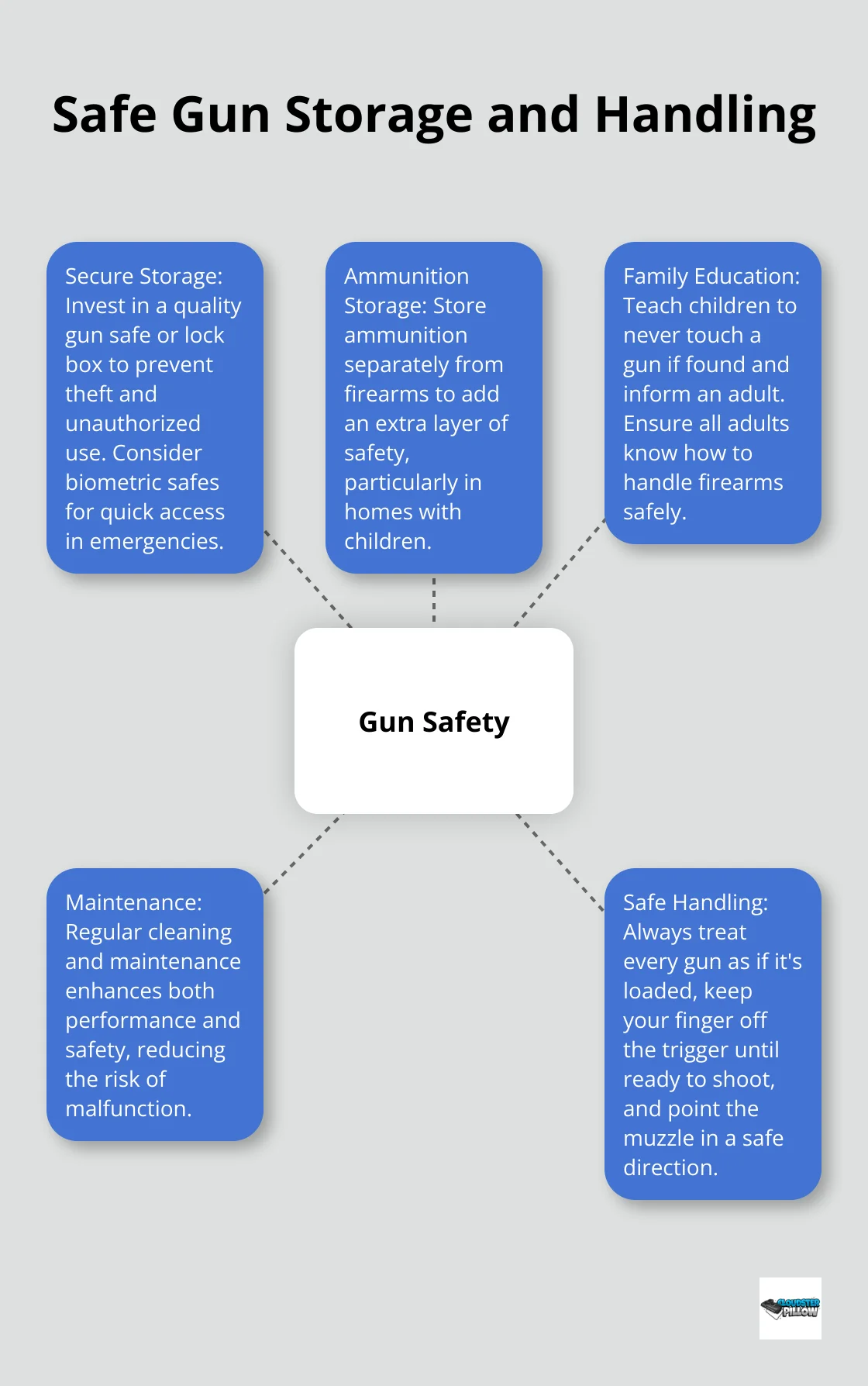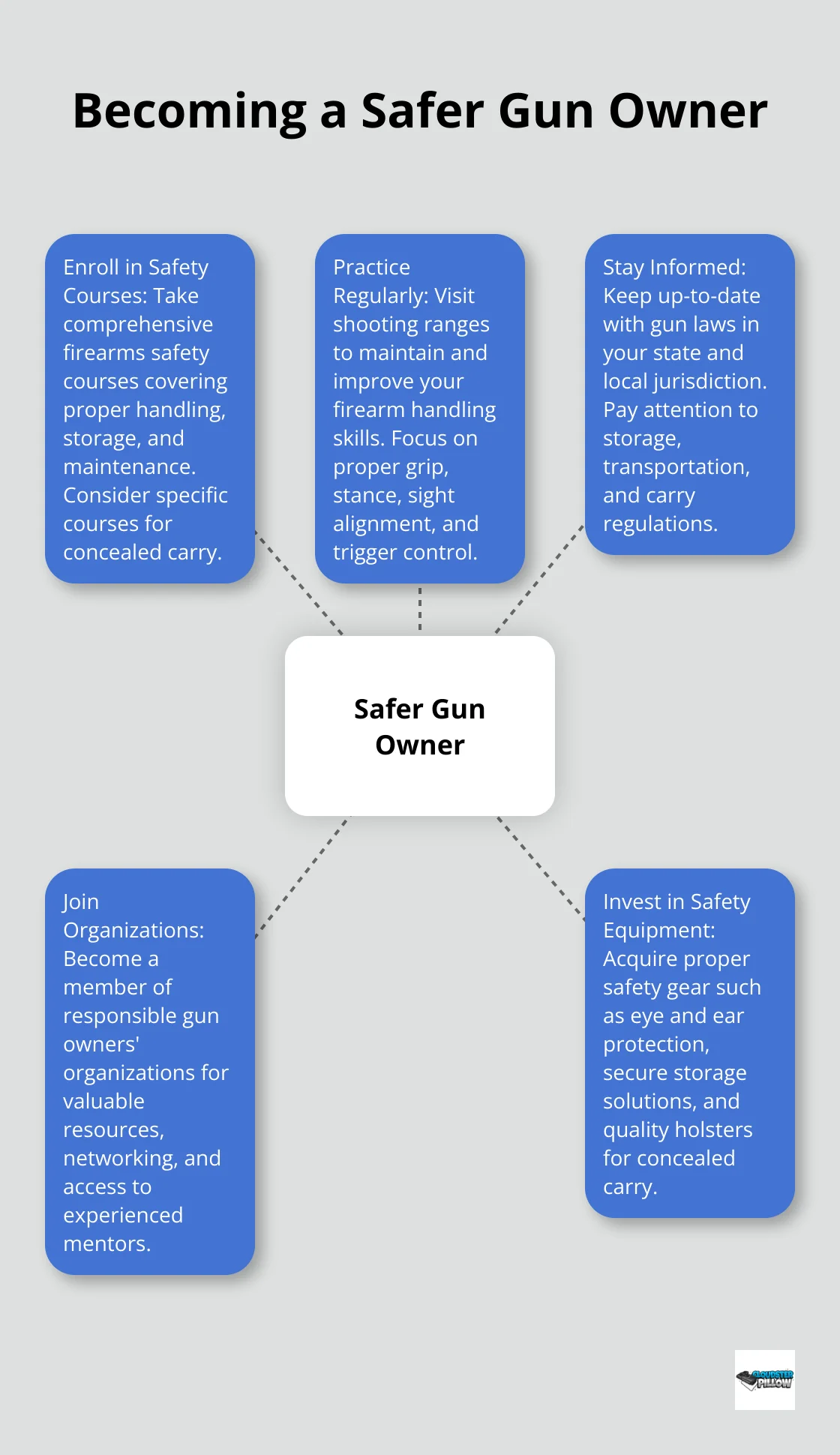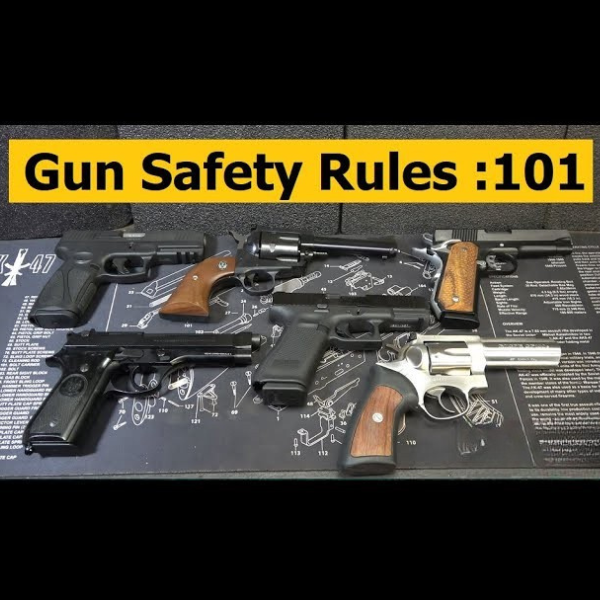CCW Awareness & Mindset, CCW Courses and Tips, CCW Training
Gun Safety Rules Every Gun Owner Should Know
Gun safety is the cornerstone of responsible firearm ownership. At Cloudster Pillow, we believe that every gun owner should prioritize safety above all else.
This guide outlines essential rules and practices to help you handle firearms safely and confidently. Whether you’re a new gun owner or a seasoned enthusiast, these principles are crucial for protecting yourself and others.
The Four Cardinal Rules of Gun Safety
At Cloudster Pillow, we understand the importance of gun safety for responsible firearm ownership. All gun owners should take certain steps to ensure that their guns are used safely, stored securely, and that they don’t end up in the wrong hands. The four cardinal rules of gun safety form the foundation of safe handling practices. These rules are non-negotiable and should be followed at all times, whether you’re at the range, hunting, or storing your firearm at home.
Rule 1: Assume Every Gun is Loaded
This rule is the cornerstone of gun safety. Always handle a firearm as if it contains live ammunition, even if you’re certain it’s unloaded. This mindset prevents complacency and reduces the risk of accidents. When you pick up a firearm, immediately check its status. Open the action, visually and physically inspect the chamber and magazine well. This habit should become second nature.
Rule 2: Muzzle Awareness is Key
Always control where the muzzle of your firearm points. A safe direction means that even if the gun were to discharge accidentally, it would not cause injury or damage. In a home setting, this might mean pointing the muzzle at a backstop capable of stopping a bullet. At a range, it means keeping the muzzle pointed downrange at all times. When holstering, use your free hand to clear clothing and ensure a smooth, safe draw. Controlling the muzzle of your firearm is an “always” requirement, so it doesn’t matter if it’s on duty or off duty.
Rule 3: Trigger Discipline Saves Lives
Keep your finger off the trigger and outside the trigger guard until you’re ready to shoot. This rule prevents unintentional discharges if you’re startled or lose your grip on the firearm. Train yourself to rest your trigger finger along the frame of the gun. This position allows for quick access to the trigger when needed while maintaining safety. Never touch the trigger on a firearm until you actually intend to shoot. Keep your fingers away from the trigger while loading or unloading.
Rule 4: Know Your Target and Beyond
Before you pull the trigger, be absolutely certain of your target and what lies beyond it. Bullets can travel through walls, doors, and other objects. In a self-defense situation, consider the potential for collateral damage. At the range, ensure your target is properly placed and that the backstop is adequate.
These four cardinal rules significantly reduce the risk of firearm-related accidents when ingrained into your muscle memory. Safety is an ongoing process that requires constant vigilance and practice. Whether you’re using a holster from top brands (like Tenicor or Tier 1 Concealed) or enhancing your setup with a Cloudster Pillow wedge, always prioritize these safety rules above all else.
Now that we’ve covered the fundamental rules of gun safety, let’s explore proper gun storage and handling practices to further enhance your firearm safety knowledge.
How to Store and Handle Your Firearm Safely
Secure Storage Solutions
A quality gun safe or lock box serves as your primary defense against theft and unauthorized use. The Gun Violence Archive indicates that in 2025, there have been 8,503 homicides/murders/unintentional deaths/defensive gun uses. You should invest in a sturdy safe that resists fire and tampering. For emergencies requiring quick access, biometric safes offer a practical solution.

Ammunition Storage
You must store your ammunition separately from your firearms. This strategy adds an extra safety layer, particularly in homes with children. Separate ammo storage reduces the risk of accidental discharge if someone accesses your gun.
Family Education
Gun safety education for your family is essential. You should teach children to never touch a gun if they find one and to inform an adult immediately. Adults in the home should know how to handle firearms safely and understand proper storage importance.
Maintenance Matters
Regular cleaning and maintenance of your firearms enhances both performance and safety. A well-maintained gun has a lower risk of malfunction, which reduces accidental discharge potential. You should follow the manufacturer’s guidelines for cleaning frequency and procedures. (If you use a holster wedge, clean it regularly too, as it can accumulate sweat and debris over time.)
Safe Handling Practices
Safe handling practices form the foundation of responsible gun ownership. You should always treat every gun as if it’s loaded, even when you’re certain it’s not. Keep your finger off the trigger until you’re ready to shoot, and always point the muzzle in a safe direction. (These habits, when ingrained, significantly reduce the risk of accidents.)
The next chapter will explore the importance of training and education for gun owners, building on these fundamental storage and handling practices to further enhance your firearm safety knowledge.
How to Become a Safer Gun Owner
Enroll in a Comprehensive Firearms Safety Course
The first step to become a safer gun owner is to take a comprehensive firearms safety course. The National Rifle Association (NRA) offers various courses for different skill levels and firearm types. These courses cover essential topics such as proper handling, storage, and maintenance of firearms. They also provide hands-on training under the supervision of certified instructors.
For those interested in concealed carry, a specific concealed carry course is recommended. These courses often include information on local laws, situational awareness, and conflict de-escalation techniques. (Even experienced gun owners can benefit from refresher courses to stay updated on the latest safety practices and legal requirements.)
Practice Regularly at a Shooting Range
Regular practice at a shooting range is essential to maintain and improve your firearm handling skills. When at the range, focus on proper grip, stance, sight alignment, and trigger control. Many ranges offer various targets and scenarios to help you practice different skills.
If you use a holster setup with a Cloudster Pillow wedge, practice your draw and re-holster techniques to ensure smooth and safe operation. Pay attention to how the wedge affects your draw stroke and adjust your technique as necessary.
Stay Informed About Gun Laws
Gun laws can vary significantly between states and even local jurisdictions. It’s your responsibility as a gun owner to stay informed about the laws that apply to you. Check reliable resources regularly, as laws can change.
Pay particular attention to laws regarding storage, transportation, and carry of firearms. Some states have specific requirements for how guns must be stored in the home, especially if children are present. Understanding these laws not only keeps you compliant but also reinforces safe practices.
Join a Responsible Gun Owners’ Organization
Joining a responsible gun owners’ organization can provide valuable resources and networking opportunities. These organizations often offer additional training, legal updates, and access to experienced mentors. (They can also be a great source of information on new safety equipment and best practices.)
Invest in Quality Safety Equipment
Proper safety equipment is a must for any gun owner. This includes eye and ear protection for use at the range, as well as secure storage solutions for your home. Consider investing in a quality gun safe or lockbox to prevent unauthorized access to your firearms.
For those who carry concealed, a high-quality holster is essential. The Cloudster Pillow wedge is designed to soften the feel of your holster while enhancing concealment, making it a must-have for any CCW or EDC setup.

FAQs
What are the four cardinal rules of gun safety?
The four cardinal rules of gun safety are:
- Assume Every Gun is Loaded: Always treat a firearm as if it’s loaded, even if you are certain it isn’t. Check the gun’s status immediately before handling it.
- Muzzle Awareness is Key: Control where the muzzle points at all times, ensuring it’s aimed in a safe direction.
- Trigger Discipline Saves Lives: Keep your finger off the trigger until you are ready to shoot. This prevents accidental discharges.
- Know Your Target and Beyond: Always be sure of your target and what lies beyond it to avoid collateral damage in a self-defense situation.
How should I store my firearm safely?
To store your firearm safely, invest in a quality gun safe or lockbox to prevent unauthorized access. Keep your ammunition separate from your firearms, especially in homes with children, and use biometric safes for quick access in emergencies. Regularly check your storage solutions to ensure they are secure and functional.
What should I do to educate my family about gun safety?
It’s crucial to educate your family, especially children, about firearm safety. Teach children not to touch firearms if they find one and to immediately alert an adult. Adults in the household should also understand safe handling practices and the importance of secure storage to prevent unauthorized access.
What maintenance practices are important for firearm safety?
Regular maintenance is essential for firearm safety. Clean and maintain your firearm according to the manufacturer’s guidelines to ensure it functions properly and reduces the risk of malfunctions. Regularly check and clean any accessories, such as holster wedges, to keep them in top condition and prevent any buildup of debris.
Why is it important to enroll in a firearms safety course?
Enrolling in a firearms safety course helps gun owners learn the basics of handling, storing, and maintaining their firearms safely. The National Rifle Association (NRA) and other reputable organizations offer courses to help you understand safety procedures, local laws, and improve your overall skill. Training also reinforces responsible gun ownership practices and helps you stay updated on the latest safety measures and legal requirements.
Final Thoughts
Gun safety forms the core of responsible firearm ownership. The four cardinal rules provide a solid foundation for safe gun handling, but true safety requires ongoing education and regular training. Firearm owners must commit to staying informed about the latest safety practices and legal requirements to refine their skills and knowledge continuously.
Proper storage, family education, and regular maintenance play vital roles in preventing unauthorized access and reducing firearm-related accidents. These steps contribute to both personal and public safety, fostering a culture of responsible gun ownership. Products like the Cloudster Pillow can enhance comfort and concealment for concealed carriers, allowing them to focus on situational awareness and safe handling practices.
Gun safety demands constant vigilance and practice from every firearm owner. Your commitment to safety, education, and proper equipment use protects you and others. This dedication ensures that firearms remain tools for sport, self-defense, and personal enjoyment, used safely and responsibly by law-abiding citizens.



Pingback: The Best Hearing Protection for Shooting in 2025 - Cloudster Pillow